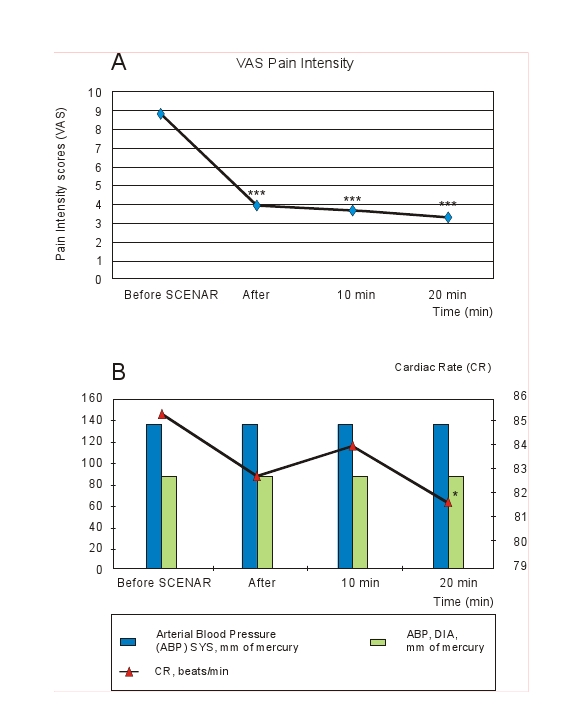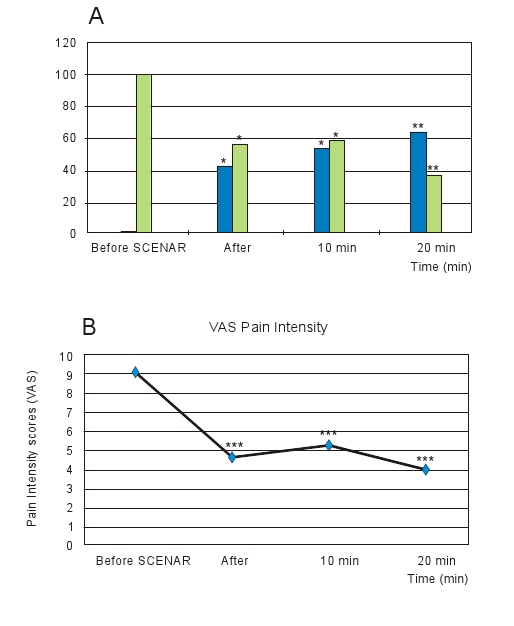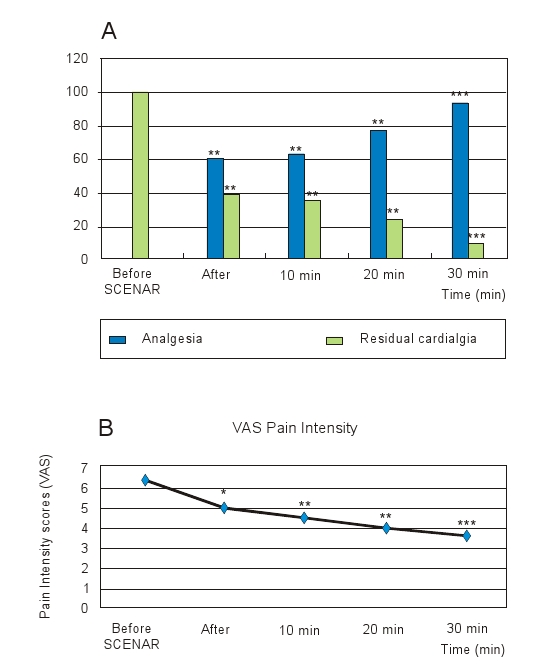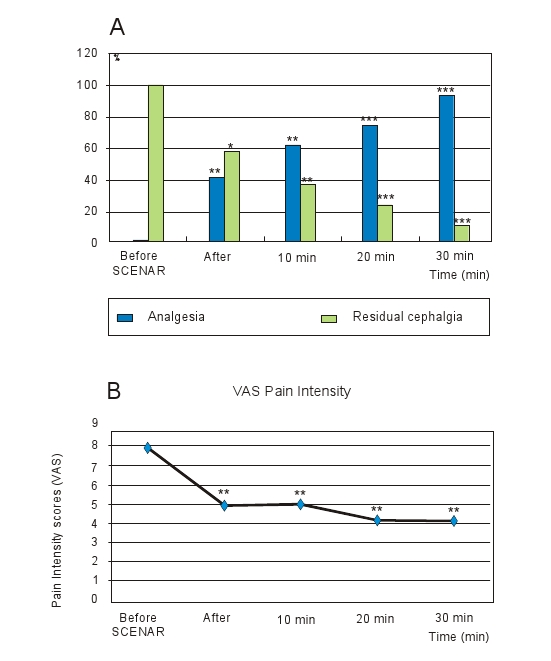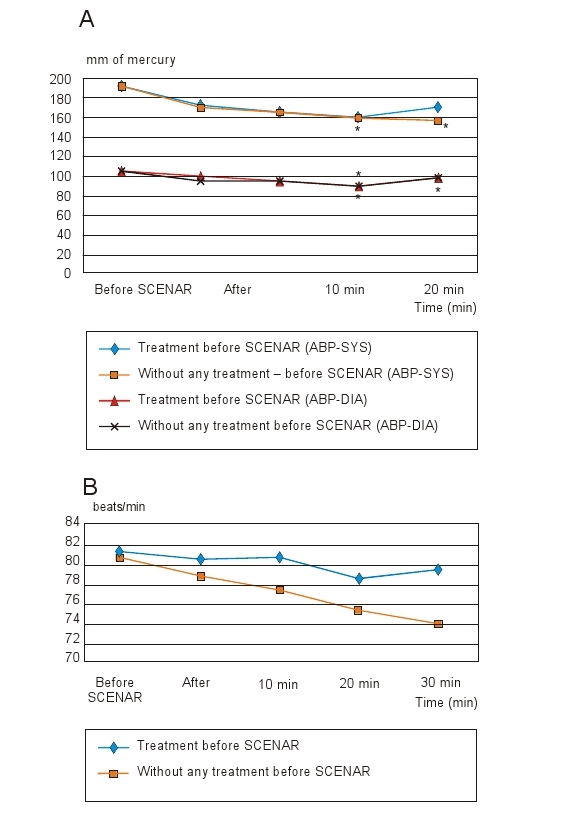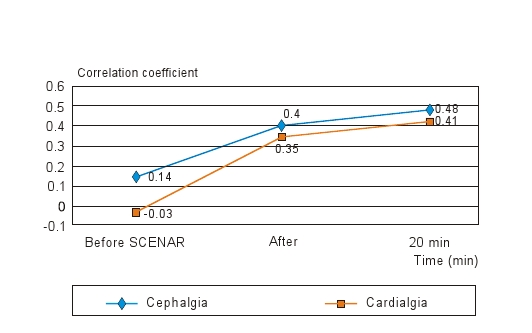
Scenar and Emergency Pain Relief
Multifactor mechanisms in Scenar analgesia.Authors: Professor A.V. Tarakanov, and E.G. Los. Emergencies Department, Specialist Training Faculty, Rostov State Medical University Publication: Reflexology Journal,
Issue No: 3 (7), 2005, Moscow, Russia More than 40 doctors of emergency departments in 13 towns in the districts of Rostov, Stavropol, Nizhni Novgorod and Adigeia took part in this research. More than 500 patients were treated with Scenar. The results of this monotherapy on pain: proved analgesic effect on traumas (n=20, 60%); analgesia against a background of normalized function of the system of organs at stenocardia (n=26, 66%) and hypertensive crises (n=153, 88-91% for cephalgia, and cardialgia respectively). The characteristics which distinguish SCENAR among electrical equipment for transcutaneous stimulation are:
Applying SCENAR therapy is an issue of huge interest due to its
availability, rapid positive effect, simplicity of treatment and steady
result. RESEARCH
OBJECTIVE MATERIALS AND METHODS The coordination of clinical tests according to
a specially developed treatment map was performed by the Emergency
department of the Faculty of Qualification and Improvement at Rostov
State Medical University, and the Department of Clinical Tests at the “RITM”
Development Bureau, in the town of Taganrog. Patients with acute pain in
three different pathological processes were selected from the database: 1) traumatic injuries of limbs, soft tissue injuries (n=20); 2) steady stenocardia
(n=26); 3) hyper-intensive crises (n=153). The therapeutic procedure was performed only once by an emergency department doctor, as the duration of
the procedure was 5-30 minutes long, depending on the effect. When the
analgesia was ineffective, the doctor could inject analgesic medicine. To
evaluate the effect of the analgesia in conditions of emergency, a visual
analog scale (VAS) was used, where 0cm = lack of pain, 10cm = maximum
pain. Processing six points on the face enables to input information
through all three terminations of the trigeminus nerve. On the other
hand biologically active points of the channels are located in these
areas. At least point V2 of the urethra, points E2 and E3 of the gastric
channel and G120 of the large intestine, and point E4 of the gastric channel are included in the area of impact of SCENAR. Analgesia with the use of SCENAR was performed on small and medium traumas: lower limbs fracture (n=5), injuries of soft tissues – limbs, thorax, without damaging respiratory functions (n=9), I and II degree burns of face and abdominal wall (n=2). Cut wounds and bites (n=4). There were nine men and 11 women aged from 11 to 82 (average age – 40.7±3.9). The patients were treated using general means: splinting, immobilization, non-adhesive bandages in cases of burn etc. The evaluation of the pain was performed using VAS before the analgesia with SCENAR, immediately after the procedure, and in the 10th and 20th minute. In the same periods of time, other complaints and symptoms were defined, as well as the parameters of hemodynamics. The data is shown in fig.1 below.
Fig.1. A - Dynamics of the analgesic effect of SCENAR during therapy of traumatic pains according to VAS.
A distinct and reliable analgesic effect developed immediately
after the procedure, almost without further increase by the 20th minute.
Observations showed that the analgesic effect increases by the 50th –
60th minute. Because the emergency staff cannot follow the efficiency of
the procedure for a long period of time, in several cases the doctor made
the decision to inject additionally non-opiate analgesic medicine (analgine, ketorolac or ketonal). Only 8 out of 20 patients were injected analgesic
medicines. Natural skepticism and caution should be noticed when doctors
tested the new method.
Fig.2. A – Dynamics of the complete analgesic effect and number of residual pains (%) during analgesia of patients with attacks of stenocardia.
A – Dynamics of the complete analgesic effect and number of residual pains (%) during analgesia of patients with cardialgia at hypertensive crisis.
In fig.4 below, the effect of the appliance can be seen for
cephalgia and hypertensive crises at the pre-hospital stage of treatment.
Fig.4 A shows reliable and gradual elimination of pain. After the
procedure the headache disappeared for 43%, and by the 30th minute, for 88% of
patients.
A – Dynamics of the complete analgesic effect and number of residual pains (%) during analgesia of patients with cephalgia at hypertensive crisis.
A typical effect of the SCENAR therapy is first to eliminate the symptoms and then normalize objective parameters. The vegetative corrective effect of SCENAR therapy should be noticed as hyperhydrosis, nausea, vomiting and excitedness are eliminated. Further observation of some patients and the experience of elimination crises in hospital conditions show that average blood pressure decreases 15-25% within 1 hour, which does not lead to ischemia of targeted organs. A reliable decrease in frequency of cardiac contractions of 9% could be noticed when eliminating crises without the previous use of medicines (fig.5b)
Fig.5. A – Dynamics of parameters of blood pressure during SCENAR therapy of hypertensive crises in the group of patients who had taken and who had not taken hypotensive medicines before the emergency staff arrived.
CONCLUSIONS
| ||||||||||
|
|
Terry Waller, Insurance Manager, London (Frozen Shoulder) "After lifting some heavy machinery, I found that trying to raise my left arm above my waist was very painful. My osteopath told me I had a frozen shoulder and although I got some relief from his treatment, he said it could take up to 12 months for things to normalise. Some weeks later I was introduced to Paul and his Scenar equipment. I was a little sceptical at first but after 2-3 sessions I began to notice improvement. To my amazement, after just 8 sessions I realised that I could raise my left arm as high and easily as my right. It's now just over a year later and I have remained completely pain free ever since. There is no hard sell with Paul who I found to be very knowledgeable and a consummate professional."
John Hayward, Engineer and Landscaper, Westham, Sussex (Neck + Shoulder Pain) "The pain had reached levels that stopped my physical workload. The diagnosis was nerve compression due to an old injury to the C5/6/7 vertebrae. After four Scenar treatments, I was able to stop the painkillers. After three months and 10 treatments I can sleep on my side again, write and sign my signature fluently again, turn my head fully to the right and left..." Six months followup: "I'm doing heavy physical work again as part of my job, and despite needing occasional top-ups, I'm basically pain-free. Altogether, a phenomenal success."
Don Elwick, Managing Director, Brighton Media Centre (Cracked Ribs) "On December 21st, 2009, I went out running, slipped on some ice, and fell heavily on my back. A nurse and a doctor both confirmed I had two or three cracked ribs. I spent the next week hardly sleeping due to the pain. On December 29th I saw Paul Lowe for a Scenar treatment, and that night I slept properly again. Over the next few days, almost all the pain had gone. I had a second Scenar treatment January 1st, and on January 4th, the doctor found it hard to believe there was nothing left from the accident."
Venus Villa, First Artist, The English National Ballet, London (Muscle Injury) "I had a very painful injury to my leg and I tried several therapies. Scenar was the best for really deep healing. Thank you Paul."
Tali Saar, Shiatsu and Cranio-Sacral Therapist, Lewes, Sussex (Facial Paralysis) "I was treated by Paul Lowe for facial paralysis, I also had pain in my face and ear canal. The pains disappeared after the first two treatments, and soon there was a huge improvement in the paralysis and my energy levels. The treatments reminded me of a deep, relaxing place I had lost for many years. I experienced changes at many levels, far beyond my original symptoms. Paul has been both supportive and inspiring. He is a unique practitioner with vast knowledge in his field."
Erica Yonge, Energy Therapist, Marlborough, Wiltshire (Back Pain) "Paul, I just wanted to say thank you so much for sorting out my back problem so effectively with Scenar. I was told I had a potential herniated disc in my lower back, and I was in a lot of pain for many years. In recent months, I was frequently unable to stand up straight for minutes at a time. After six Scenar sessions, not only am I completely pain free in my back for the first time in years, but my posture has corrected itself naturally. I wouldn't have believed I could be this pain free after so many years of pain. Eighteen months followup: My back is still very good and posture is better than it's ever been. If you weren't so far away, I'd come for regular top-ups!"
Lucienne Atkinson, Business Owner, Oulston, Yorkshire (Back Pain) "Life had been years of debilitating pain. I was at my wit's end. Finding Paul Lowe and the Scenar treatment has been nothing short of a miracle for me. After two long treatments with him, the worst problem area for pain changed, almost disappeared." 18 months followup: "It's truly a miracle. I have gone back to the athletic person I was before. I can train hard on my mountain bike for 3 or 4 days in a row with no back pain!"
Tim Cornwall, Works Manager, Herstmonceaux, Sussex (Back Pain) "I've had hip and lower back problems for over 30 years. This episode was the worst I've had for two years: I could hardly walk or drive. Until now, I'd go to the chiropractor for several treatments and take at least three weeks to recover. With Paul it took five days and four Scenar treatments to get back to normal. On day 1, I could barely walk. On day 3, I took the dog for a one-hour walk."
Barry Chapman, Designer, Hove, Sussex (Leg pain) "I would recommend anybody with health challenges to talk to Paul. I had a combination of polymyalgia, extremely sore feet, low energy and limited mobility. I thought I had tried everything and had resigned myself to sliding down the slippery slope. Paul, his guidance and treatments, gave me hope when I had none, and for this I am extremely thankful. I've adjusted my lifestyle and diet and worked hard. I am now fit, energetic and strong."
Angela Gilroy, Media Designer, London (Back Pain) "When I hurt my lower back, the pain made it impossible to move my right leg backwards when walking, so I had to shuffle. Paul Lowe gave me a brief Scenar treatment that night and I felt some relief immediately and got a good night's sleep. The next morning he gave me a full back treatment, and this produced a major change. It still felt a little tender but I could walk around almost normally."
Marco Crivello, Artist, Lewes, Sussex (Shoulder + Back Pain) "I had acute pain in my right shoulder. I tried osteopathy and cranio-sacral over several weeks, but with negligible results. Paul treated me with Scenar daily for four days, and by the end I was pain-free. On another occasion, I was in acute pain months after Achilles tendon surgery -- after one treatment from Paul, the pain went away. I also threw my back out twice. Each time, one Scenar treatment was enough to put it back to normal."
Stephanie Davies-Arai, Sculptor, Lewes, Sussex (Back Pain) "I was rushed to hospital on three occasions and given four strong painkillers including morphine. I finally collapsed at work in agony, unable to walk. After 10 daily treatments with Paul, I was able to stop the painkillers and drive 80 miles to a work event." Six months followup: "I'm still pain free."
Phil Turtle, Company Director, Brighton (Fracture, Post Surgery) "I broke the humerus bone in my arm and had it operated on, in January 2014. I then had frequent Scenar and pulsed electromagnetic field treatments from Paul Lowe and quickly regained use of the arm. Five weeks after the operation, I saw my consultant and he was obviously shocked at how 'back to normal' my arm was at such an early stage."
Dolores Goodey, School Teacher, Newhaven, Sussex (Chronic Whiplash Pain) "It works, and I tried everything. I have more energy and I'm sleeping well. I used to get aches all the way down my back but not now. I'm also impressed that the treatments had such long lasting effects."
Plesae note: These testimonials are from real individuals but since every individual is unique, there is no guarantee that others will experience the same results.
|
Email: . E
All Rights Reserved: Health Techs. © Copyright: Paul Lowe, 2008-2019.
